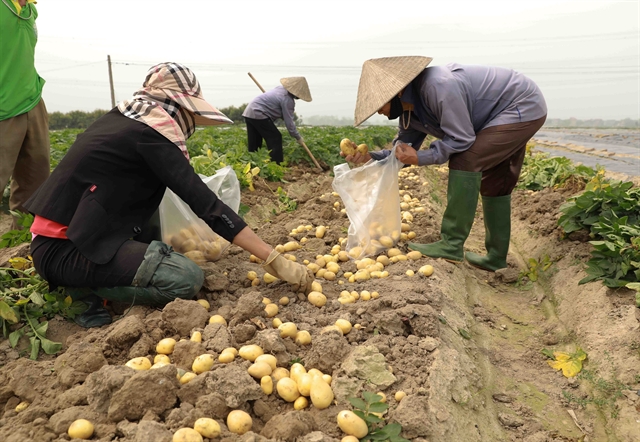 Society
Society


|
| Yên Dũng Organic Vegetable Cooperative in Tiến Dũng Commune, Yên Dũng District in northern Bắc Giang Province provides about 200 tonnes of products for domestic and foreign markets. VNA/VNS Photos Vũ Sinh |
HÀ NỘI – The collective economy and cooperatives have made new developments, overcoming prolonged weaknesses and helping connect farmers, businesses, and build a rural ecosystem.
However, there is a need for changes in the operation and management of the collective economy to fully tap its potential, experts have said.
The collective economy and cooperatives have been present in Việt Nam for a long time. During the period from 1955-1985, cooperatives were formed to gather small producers in a trade and each member was assigned a specific job.
After the transition from a subsidy economy to a market-oriented economy between 1986-1996, the collective economy and cooperatives faced many difficulties and many cooperatives were ineffective.
In 2012, the Law on Cooperatives was introduced, helping to establish a clear and specific direction for cooperatives, especially agricultural cooperatives. Ten years since the Law on Cooperatives came into effect, cooperative units and clusters have been established, forming a collective entity with legal status, production and consumption plans, and specific quality criteria to negotiate with domestic and even international buyers.
The Central Institute for Economic Management reported that since the Law on Cooperatives was born, the cooperative economy has directly contributed an average of 48 per cent to the country's GDP.
By the end of 2022, there were nearly 30,000 cooperatives, 125 cooperative federations, and 71,000 cooperative clusters nationwide. Of that, there are 35,000 agricultural cooperative clusters, 19,500 agricultural cooperatives, and 91 agricultural cooperative federations, attracting 3.8 million members and providing 1.5 million jobs.
Cooperatives, particularly agricultural ones, have connected small and individual farming households into a larger group, and helped determine their production and consumption amid intense competition.
Ngô Minh Long, Chairman of the Hậu Giang Cooperative Alliance, said that the Mekong Delta is an area with strong potential for agriculture. Without the model of cooperatives, most farmers in this region would struggle and compete with each other to find outlets for their products. With cooperatives, each farmer only needs to perform their duties well and produce high-quality products according to the requirements of customers, leading to success for the entire group of farmers.
Nguyễn Quốc Bảo, Chairman of the Board of Directors of the Bến Tre Green Grapefruit Cooperative, shared that since its establishment, the cooperative had only 69 members, but now has attracted more than 310 members.
Cooperative members have many opportunities to collaborate with agricultural cooperatives in Canada, exchange experience in producing green grapefruits and find customers, he added.
Modest efficiency
However, the efficiency of the collective economy in the past 20 years has been modest.
Minister of Planning and Investment Nguyễn Chí Dũng said the growth rate of the collective economy was only 50 per cent of the overall economic growth rate.
To develop the collective economy and cooperatives, Dũng said that it is necessary to improve the institutional framework and technical infrastructure of rural and mountainous areas.
At the same time, the workforce should be improved to manage cooperatives along the value chain. In particular, the cooperatives need to promote the advantages of member scale, and attract more members for further development.
Minister of Agriculture and Rural Development Lê Minh Hoan said in addition to the management of human resources of each cooperative, the role of local authorities is very important. The more attention local leaders pay to the collective economy, the more quality cooperatives are active in that area.

|
| Farmers in Sao Thần Nông Cooperative in Tiến Dũng Commune, Yên Dũng District in Bắc Giang Province harvest potatoes. |
All levels and sectors need to support cooperatives with resources already linked to sustainable rural development strategies. In order to effectively develop the collective economy, the National Assembly has recently undertaken a project to revise the 2012 Cooperative Law, creating opportunities for cooperatives to access resources for development, he added.
Nguyễn Tiến Định, representative of the Cooperative and Rural Development Economics Division under the Ministry of Agriculture and Rural Development said among more than 18,700 agricultural cooperatives, only about 3.7 per cent have access to credit annually.
This difficulty in accessing preferential loans from the commercial banking system has caused the cooperatives to lack the economic resources to invest in processing, leading to a focus on harvesting with low productivity, limiting the formation and development of supply chains.
New targets
In mid-June 2022, the Government issued Decision No799/QD-TTg to develop a revised Cooperative Law project.
The development of the collective economy has become a crucial task to promote the country's economy. A resolution on continuing to innovate, develop and improve the efficiency of the collective economy in the new period was passed at the fifth plenum of the 13th Party Central Committee.
It targets that by 2030, the country will have approximately 140,000 cooperative groups with two million members, 45,000 cooperatives with eight million members, and 340 cooperative federations with 1,700 member cooperatives.
More than 60 per cent of collectives are expected to reach a good or fair development level, with at least 50 per cent participating in value chain linkages.
Additionally, the country aims to have over 5,000 cooperatives applying high technology to agricultural production and consumption, developing agricultural value chains linked to production, providing processing services and product consumption, and promoting participation in supply chains for export.
To achieve these goals, many initiatives have been implemented. The application of high technology and digital transformation in the production and consumption of agricultural products is a big step forward for the cooperatives.
Nguyễn Đức Phương, Chairman of Cần Thơ City's Cooperative Alliance said that the group has supported more than 40 cooperatives to exchange information, buy and sell goods on social networks.
They have also supported the introduction of products with food safety certificates or VietGAP certificates, and products that have been certified under the One Commune One Product (OCOP) programme on e-commerce trading floors such as Posmart.vn, Voso.vn, and chonongsancantho.vn.
This has gradually helped cooperatives transform their business methods and increase their competitiveness in the market.
Phạm Ngọc Đá, Director of the Giọt Phù Sa Agriculture Technology Cooperative in Phong Điền District in Cần Thơ City shared that the cooperative uses QR codes to trace the origin of products and also sells products on e-commerce trading floors. This has not only increased customers’ trust but also helped the cooperative improve business efficiency.
Currently, their products are widely sold in provinces in the Mekong Delta region and HCM City. The products are also sold through e-commerce platforms such as Tiki, Lazada, and Posmart.vn.
This has brought high economic efficiency to the cooperative, contributing to stable income for more than 20 labourers with a monthly income of VNĐ5-8 million per person.
Phương said the group has proposed to continue to coordinate with relevant departments and branches of the city to organise training courses to help the cooperatives apply information technology in production and consumption.
This will help the cooperatives access and effectively apply digital solutions to their production and business activities, developing sustainably and adapting to the market, he said. – VNS




